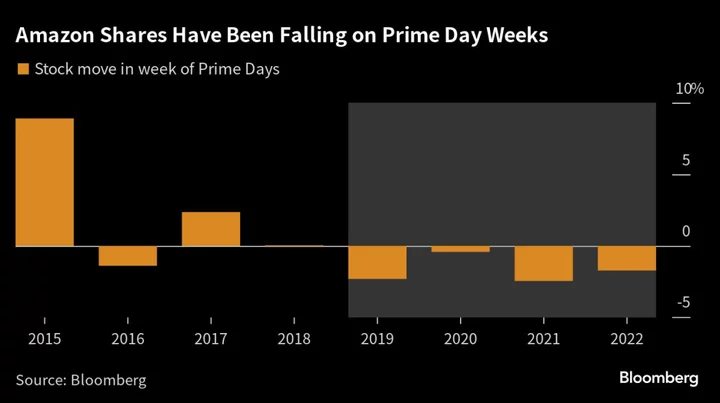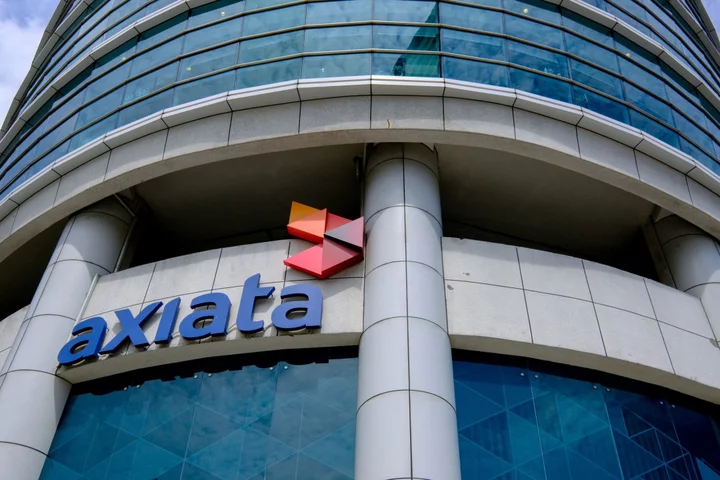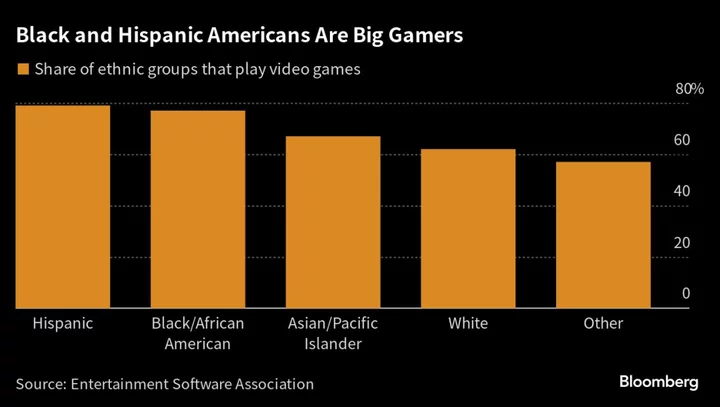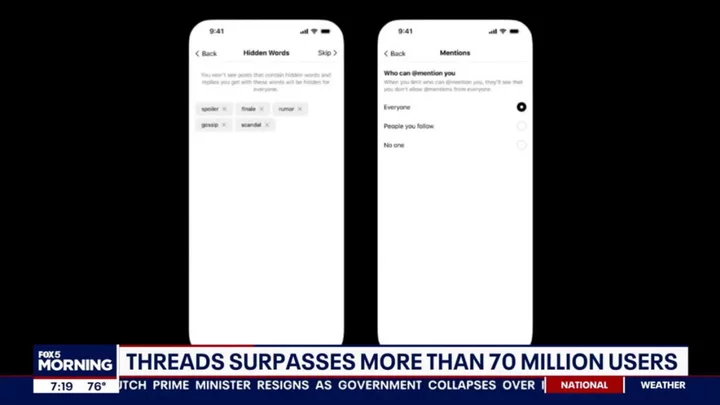
Amazon Prime Day Isn’t the Catalyst It Used to Be
Amazon.com Inc.’s annual Prime Day shows that e-commerce isn’t the driver it once was for the stock, as
1970-01-01 08:00

India Billionaire’s Chip Foray Faces Setback as Foxconn Exits
Anil Agarwal’s $19 billion semiconductor-making ambitions in India were dealt another setback after his Taiwanese partner decided to
1970-01-01 08:00

Axiata Eyes Unit Stake Sales as Debt Swells on Overseas Push
Axiata Group Bhd., Malaysia’s biggest wireless carrier by revenue, plans to sell stakes in some of its businesses
1970-01-01 08:00

Hispanic and Black Americans Are the Most Likely to Play Video Games
Hispanic and Black Americans play video games more than other groups, according to an annual industry report, bucking
1970-01-01 08:00

Israel Braces for More Upheaval as Judicial Bill Edges Forward
Israel is braced for a new wave of turmoil as Prime Minister Benjamin Netanyahu’s government pushes ahead with
1970-01-01 08:00

Fertilizer company OCI bets big on climate-friendly ammonia
By Rod Nickel and Victoria Klesty Without a single sales contract in hand, Dutch fertilizer company OCI is
1970-01-01 08:00

Automated Weather Insurance Could Offer Help in an Increasingly Hot World
Carlos José Báez experienced the full brunt of Hurricane Maria when it made landfall in Puerto Rico as
1970-01-01 08:00

Threads ‘666’ logo conspiracy theory can be undermined by one simple historical fact
Since Instagram’s text-based alternative to Twitter, Threads, rolled out last week, a handful of memes and conspiracy theories have surfaced around the app’s unusual ‘at symbol’-like logo – from the inaccurate suggestion it was predicted by The Simpsons (it wasn’t), and now, to claims it’s actually linked to the devil (it isn’t). The baseless theory - seemingly backed by Twitter owner Elon Musk himself, if his public tweet likes are anything to go by – suggests the swirly icon secretly contains the number ‘666’, often referred to as “the number of the beast” and considered a link to the Antichrist. Sign up to our free Indy100 weekly newsletter Claiming they “can’t stop seeing it”, one Twitter user asked: “Does anyone else think the Threads logo just looks like 666? The first 6 is forward and white, then the second one is smaller and backwards, and the third one is the black space inside.” “How to put 666 ‘the number of the beast’ into a logo,” wrote another, in a tweet liked by Musk. Several other accounts have branded Threads “satanic” over the supposed link. In fact, the baseless claim became so popular that Instagram boss Adam Mosseri shared a thread on Friday explaining the real meaning behind the logo. “The Threads logo, in Instagram Sans, is inspired by the @ sign, which stands for someone’s username, the individual, and voice. “It’s a single unbroken line, inspired by the loop seen in the app when a thread is started,” he wrote. When one user commented that it “would have been entertaining” if Mosseri jokingly confirmed the conspiracy to be true, the exec replied: “It was tempting, but I feel like that kind of sass would just blow up in my face.” Sensible. Of course, this is just one fact which dispels this conspiracy theory as nonsense and baseless, but one lesser-known bit of historical trivia also exposes just how outlandish the claim is. All the way back in 2005, it was reported that a newly discovered fragment of the oldest version of the New Testament – the second part of the Bible – from the third century gave a different number entirely for the number of the beast. Found in historic dumps near Oxyrhynchus in Egypt, the text from the Book of Revelation indicates it’s not 666 which is the fiendish number we should all be fearing, but the far less aesthetically pleasing 616. Professor David Parker, Professor of New Testament Textual Criticism and Paleography at the University of Birmingham, said: “This is an example of gematria, where numbers are based on the numerical values of letters in people’s names. “Early Christians would use numbers to hide the identity of people who they were attacking: 616 refers to the Emperor Caligula.” This is in contrast to the far more popular 666, which is understood to have referred to Emperor Nero. Have your say in our news democracy. Click the upvote icon at the top of the page to help raise this article through the indy100 rankings.
1970-01-01 08:00

Ocado launches first robotic warehouse in Asia with Aeon
LONDON British online supermarket and technology group Ocado said on Monday its first robotic warehouse in Asia, built
1970-01-01 08:00

Instagram Threads hits 100 million users, becoming easily the fastest growing app ever
Instagram’s Threads app has reached 100 million users, making it easily the fastest growing app ever. The site reached the number early on Monday morning, according to a tracker that looks at the numbers that are made public on each Threads account.
1970-01-01 08:00

Reliance Rallies on Finance Unit Listing, Retail Buyback Plans
Reliance Industries Ltd. rallied the most in more than three months after India’s biggest firm by market value
1970-01-01 08:00

Twitter restores old, ‘better’ version of TweetDeck – but for how long?
Twitter has backtracked to the older, freely accessible version of its TweetDeck platform just days after launching what the company claimed to be a “new, improved version”. “We have just launched a new, improved version of TweetDeck,” Twitter announced last week, adding that in 30 days, only users subscribed to the platform’s premium subscription service Twitter Blue would have access to the tool. However, the social media company restored its old TweetDeck version along with free API access with no announcement of its return from either Elon Musk or Twitter’s new chief Linda Yaccarino. TweetDeck is an app using Twitter’s API which enables users to view multiple feeds in customisable columns. While it was launched as a free-to-use independent app in 2008, it was then acquired by Twitter, and was recently turned into a paid feature. Several third-party apps such as “Harpy” shut down after the social media company began charging for access to its API – the system used to communicate with other services – as part of efforts to generate new revenue sources. “Without free access to the Twitter api, Harpy will stop working on February 9th. This includes access using a (free) custom api key. Thanks for using harpy,” the app’s Twitter account noted. TweetDeck’s new version, which also uses Twitter’s API, experienced a temporary outage last week, after Twitter decided to limit the number of tweets users can view. Twitter users also noted that while the new version of TweetDeck came with added tools like a Tweet composer and video docking, it didn’t have an Activity Tab which is deemed an important feature. Now, following the launch of Meta’s rival app Threads last week, many users have flagged that the old TweetDeck is back along with its legacy API working, which would allow the platform’s third-party apps to work again. However, without any official announcement of Twitter backtracking to the old TweetDeck, it remains unclear for how long the freely accessible “better” version would remain. Developers such as Roberto Doering, creator of the Harpy app, say Twitter is “most likely” to shut down access to their legacy API again. “Please note that this doesn’t mean that Harpy will be maintained again, seeing as Twitter will most likely shut down access to their legacy API (again) soon and third-party apps are still against their [terms of service],” Mr Doering wrote on Harpy’s GitHub page. Read More Threads: What is it, can it rival Twitter and what are the risks? Tweetdeck down: Major Twitter client not working amid chaos on site New Meta app Threads ‘first credible threat’ to Twitter Account tracking Elon Musk’s jet is now on Threads after Twitter suspended it Elon Musk says ‘Zuck is cuck’ as Threads inches closer to 100m users Threads hits 70 million sign-ups on its second day
1970-01-01 08:00
